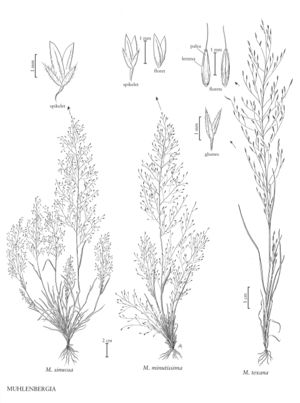Muhlenbergia texana
Plants annual; slender. Culms 10-35 cm, erect; internodes strigulose. Sheaths shorter or longer than the internodes, strigulose; ligules 0.9-2.5 mm, hyaline, acute to obtuse, irregularly toothed to lacerate; blades 1-6 (8) cm long, 0.8-2 mm wide, flat or involute, scabrous and sparsely strigulose on both surfaces. Panicles 9-21 cm long, 2-7 cm wide; primary branches 12-60 mm, occasionally capillary, narrowly ascending or diverging up to 70° from the rachises; pedicels 2-7 mm, usually longer than the florets, straight to somewhat curved, rarely bent as much as 90°; disarticulation above the glumes. Spikelets 1.3-2 mm. Glumes sparsely strigulose, particularly on the margins, 1-veined, acute to acuminate; lower glumes 0.8-1.2 mm; upper glumes 0.9-1.5 mm, bases slightly wider than the lower glumes; lemmas 1.3-2 mm, lanceolate, purplish to brown, shortly appressed-pubescent on the lower 1/2 of the midveins and margins, apices acute to acuminate, awned, awns 0.1-1 (2) mm; paleas 1.3-2 mm, oblongelliptic, minutely appressed-pubescent on the lower 1/2, apices acute; anthers 0.4-0.5 mm, purplish. Caryopses 0.8-1 mm, fusiform, brownish. 2n = 40.
Distribution
Ariz., N.Mex., Tex.
Discussion
Muhlenbergia texana grows on open slopes, in sandy, gravelly drainages, and on rock outcrops, at elevations of 1200-2750 m. Its range extends from the southwestern United States into northwestern Mexico.
Selected References
None.
Lower Taxa
"decumbent" is not a number.
